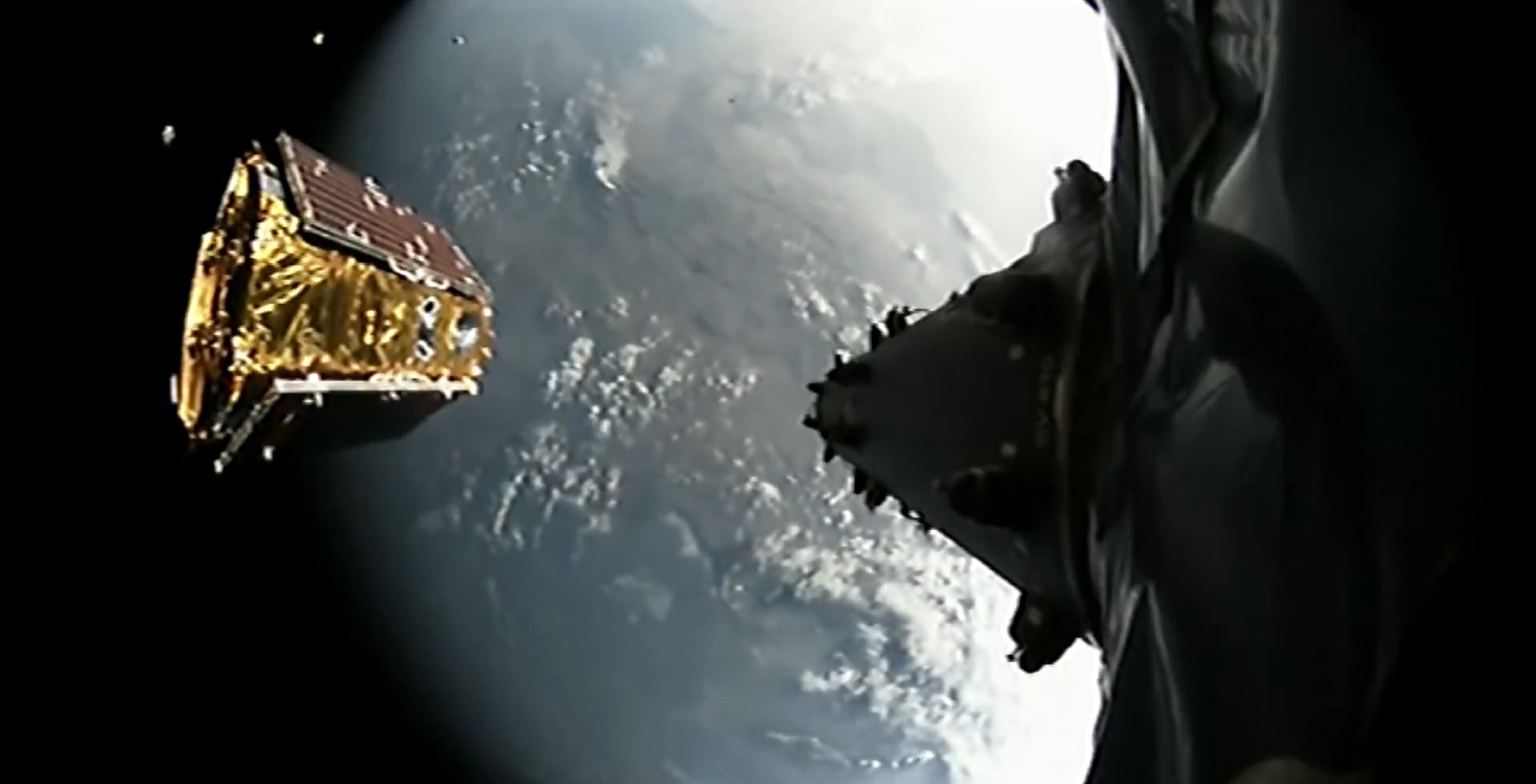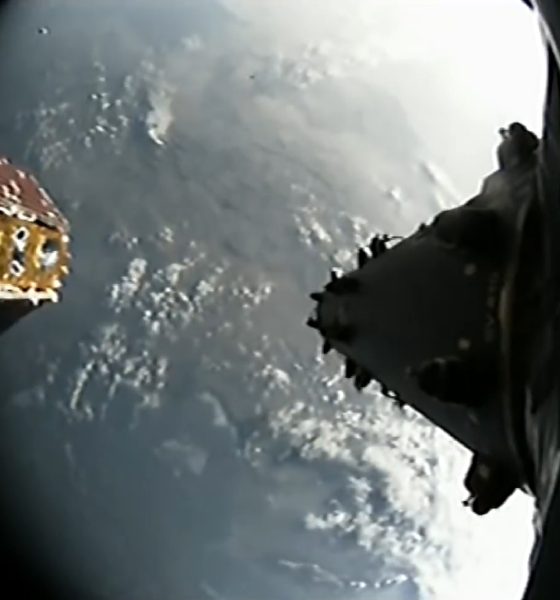

News
SpaceX has all the Starlink funding needed for an “operational constellation”
Upper-level wind shear has unfortunately scrubbed SpaceX’s first dedicated Starlink launch attempt, pushing Falcon 9 B1049’s third liftoff to no earlier than 10:30 pm EDT (02:30 UTC), May 16th.
A few hours prior to the launch attempt, SpaceX CEO Elon Musk hosted a conference call with members of the press and answered a number of questions about Starlink, providing the best look yet into the company’s newest endeavor. Topics included the advanced technologies on each Starlink satellite, their extremely unorthodox deployment method, SpaceX’s ultimate goals for the constellation, and even a few brief comments on funding.
Funding, secured
Perhaps the single most important thing Musk noted in the hour-long media briefing was his belief that SpaceX already has “sufficient capital to build an operational constellation.” It’s possible that that statement is heavily qualified, as Musk did not delve into greater detail, but it is still an incredible claim that could mean Starlink is far ahead of competing constellations and far more capital-efficient than OneWeb.
As previously discussed on Teslarati, in the last four years, OneWeb has raised $3.4B of funding, while SpaceX – a company primarily focused on building and launching rockets – has raised $2B, half of which is known to be dedicated to Starlink. OneWeb’s constellation (either 650 or 2650 satellites) cost estimate has grown quite a bit recently and stands at ~$5B. Assuming all $2B of the funding SpaceX has raised is dedicated to Starlink, that would translate to a per-satellite cost – including all infrastructure and launch – of $450,000 for the first phase (~4400 satellites).
Musk’s contextual definition of an “operational constellation” is probably more in line with the twelve 60-satellite launches he described as necessary to provide “significant [broadband] coverage”. It could also refer to the entire tranche of ~1600 Starlink satellites planned for the lower 550 km (340 mi) orbit this first batch of 60 is headed for, a number that Musk stated would offer “decent global coverage”. Either way, Starlink is almost certainly far more capital-efficient than OneWeb, LeoSat, Telesat, or any other satellite constellation with serious intentions.
The most obvious explanation for this – regardless of the satellites themselves – is simple: SpaceX owns its own closed-loop launch capability, including pads, integration facilities, an established cross-country transport network, and the rockets (Falcon) themselves. For any of the proposed satellite constellations to succeed, the manufacturers will almost invariably need to find build satellites so affordably that the cost of launch outweighs the cost of its payload. This ultimately means that launches alone could account for something like 50% of the cost of an entire satellite constellation.
Assuming Block 5 boosters can be reused at least 5-10 times each, the only real cost of an internal SpaceX launch is the hours worked, recovery fleet operations, and the expended upper stage and fairing – likely less than $30M altogether. As such, SpaceX may already be achieving its satellite cost targets on its first launch.
Deploying satellites “like spreading a deck of cards”
Meanwhile, Musk also offered some detail on the deeply unorthodox method SpaceX has chosen for spacecraft deployment once in orbit. Apparently, Starlink satellites will be deployed from Falcon 9’s upper stage by rotating the stage (presumably along its vertical axis) and simply letting go of the spacecraft. Musk used the analogy of spreading a deck of cards on a table, seemingly suggesting that they will either be released simultaneously (perhaps by stack) or with a stagger measured in milliseconds. This could create a fairly spectacular visual, forming an evenly-spaced spiral of satellites spreading out from the Falcon upper stage.
Above all else, Musk mainly seemed to be excited about Starlink, whether discussing the constellation’s long-term goals or the technology utilized on each individual satellite. Some miscellaneous facts and tidbits taken from the Q&A can be found below:
- Aside from Ka-band antennas and inter-satellite laser links, these 60 Starlink spacecraft are very close to the final spacecraft design.
- “It’s one of the hardest engineering projects that I’ve ever seen done.” – Elon Musk
- Starlink v0.9 is SpaceX’s heaviest payload ever by a huge margin, weighing in around 18,500 kg (40,800 lb). Crew Dragon is most likely in second-place, with a launch mass estimated to be around 13,500 kg.
- Combined, the solar arrays on the 60 Starlink spacecraft will produce up to 50% more power than the International Space Station’s football field-sized panels. This translates to ~180 kW, with each spacecraft thus producing around 3 kW total with an unusual single-panel array.
- Two solar array deployment mechanisms will be tested on this mission.
- “We see this as a way to generate revenue to develop more advanced rockets and spaceships. Starlink is a key component for establishing a presence on the moon and Mars.” – Elon Musk
- SpaceX sided with krypton-fueled Hall effect thrusters due to krypton costing 5-10x less than more traditional xenon propellant. SpaceX’s internally-designed and built thrusters will have an ISP of ~1500s.
- “[SpaceX has built] the most advanced phased array antenna[s] that I am aware of.” – Elon Musk
- These first 60 satellites alone will have a combined bandwidth of 1 terabit per second (125 GB/s), averaging around 17 Gbps per satellite.


Check out Teslarati’s Marketplace! We offer Tesla accessories, including for the Tesla Cybertruck and Tesla Model 3.

Elon Musk
Delaware Supreme Court reinstates Elon Musk’s 2018 Tesla CEO pay package
The unanimous decision criticized the prior total rescission as “improper and inequitable,” arguing that it left Musk uncompensated for six years of transformative leadership at Tesla.

The Delaware Supreme Court has overturned a lower court ruling, reinstating Elon Musk’s 2018 compensation package originally valued at $56 billion but now worth approximately $139 billion due to Tesla’s soaring stock price.
The unanimous decision criticized the prior total rescission as “improper and inequitable,” arguing that it left Musk uncompensated for six years of transformative leadership at Tesla. Musk quickly celebrated the outcome on X, stating that he felt “vindicated.” He also shared his gratitude to TSLA shareholders.
Delaware Supreme Court makes a decision
In a 49-page ruling Friday, the Delaware Supreme Court reversed Chancellor Kathaleen McCormick’s 2024 decision that voided the 2018 package over alleged board conflicts and inadequate shareholder disclosures. The high court acknowledged varying views on liability but agreed rescission was excessive, stating it “leaves Musk uncompensated for his time and efforts over a period of six years.”
The 2018 plan granted Musk options on about 304 million shares upon hitting aggressive milestones, all of which were achieved ahead of time. Shareholders overwhelmingly approved it initially in 2018 and ratified it once again in 2024 after the Delaware lower court struck it down. The case against Musk’s 2018 pay package was filed by plaintiff Richard Tornetta, who held just nine shares when the compensation plan was approved.
A hard-fought victory
As noted in a Reuters report, Tesla’s win avoids a potential $26 billion earnings hit from replacing the award at current prices. Tesla, now Texas-incorporated, had hedged with interim plans, including a November 2025 shareholder-approved package potentially worth $878 billion tied to Robotaxi and Optimus goals and other extremely aggressive operational milestones.
The saga surrounding Elon Musk’s 2018 pay package ultimately damaged Delaware’s corporate appeal, prompting a number of high-profile firms, such as Dropbox, Roblox, Trade Desk, and Coinbase, to follow Tesla’s exodus out of the state. What added more fuel to the issue was the fact that Tornetta’s legal team, following the lower court’s 2024 decision, demanded a fee request of more than $5.1 billion worth of TSLA stock, which was equal to an hourly rate of over $200,000.
Delaware Supreme Court Elon Musk 2018 Pay Package by Simon Alvarez
News
Tesla Cybercab tests are going on overdrive with production-ready units
Tesla is ramping its real-world tests of the Cybercab, with multiple sightings of the vehicle being reported across social media this week.

Tesla is ramping its real-world tests of the Cybercab, with multiple sightings of the autonomous two-seater being reported across social media this week. Based on videos of the vehicle that have been shared online, it appears that Cybercab tests are underway across multiple states.
Recent Cybercab sightings
Reports of Cybercab tests have ramped this week, with a vehicle that looked like a production-ready prototype being spotted at Apple’s Visitor Center in California. The vehicle in this sighting was interesting as it was equipped with a steering wheel. The vehicle also featured some changes to the design of its brake lights.
The Cybercab was also filmed testing at the Fremont factory’s test track, which also seemed to involve a vehicle that looked production-ready. This also seemed to be the case for a Cybercab that was spotted in Austin, Texas, which happened to be undergoing real-world tests. Overall, these sightings suggest that Cybercab testing is fully underway, and the vehicle is really moving towards production.
Production design all but finalized?
Recently, a near-production-ready Cybercab was showcased at Tesla’s Santana Row showroom in San Jose. The vehicle was equipped with frameless windows, dual windshield wipers, powered butterfly door struts, an extended front splitter, an updated lightbar, new wheel covers, and a license plate bracket. Interior updates include redesigned dash/door panels, refined seats with center cupholders, updated carpet, and what appeared to be improved legroom.
There seems to be a pretty good chance that the Cybercab’s design has been all but finalized, at least considering Elon Musk’s comments at the 2025 Annual Shareholder Meeting. During the event, Musk confirmed that the vehicle will enter production around April 2026, and its production targets will be quite ambitious.
News
Tesla gets a win in Sweden as union withdraws potentially “illegal” blockade
As per recent reports, the Vision union’s planned anti-Tesla action might have been illegal.

Swedish union Vision has withdrawn its sympathy blockade against Tesla’s planned service center and showroom in Kalmar. As per recent reports, the Vision union’s planned anti-Tesla action might have been illegal.
Vision’s decision to pull the blockade
Vision announced the blockade in early December, stating that it was targeting the administrative handling of Tesla’s facility permits in Kalmar municipality. The sympathy measure was expected to start Monday, but was formally withdrawn via documents sent to the Mediation Institute and Kalmar Municipality last week.
As noted in a Daggers Arbete report, plans for the strike were ultimately pulled after employer group SKR highlighted potential illegality under the Public Employment Act. Vision stressed its continued backing for the Swedish labor model, though Deputy negotiation manager Oskar Pettersson explained that the Vision union and IF Metall made the decision to cancel the planned strike together.
“We will not continue to challenge the regulations,” Petterson said. “The objection was of a technical nature. We made the assessment together with IF Metall that we were not in a position to challenge the legal assessment of whether we could take this particular action against Tesla. Therefore, we chose to revoke the notice itself.”
The SKR’s warning
Petterson also stated that SKR’s technical objection to the Vision union’s planned anti-Tesla strike framed the protest as an unauthorized act. “It was a legal assessment of the situation. Both for us and for IF Metall, it is important to be clear that we stand for the Swedish model. But we should not continue to challenge the regulations and risk getting judgments that lead nowhere in the application of the regulations,” he said.
Vision ultimately canceled its planned blockade against Tesla on December 9. With Vision’s withdrawal, few obstacles remain for Tesla’s long-planned Kalmar site. A foreign electrical firm completed work this fall, and Tesla’s Careers page currently lists a full-time service manager position based there, signaling an imminent opening.











